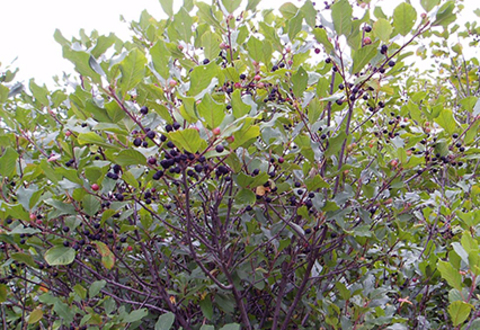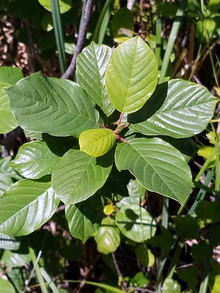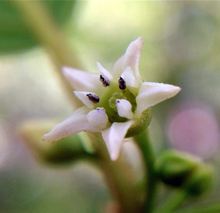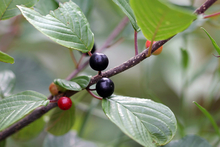Quick facts
Glossy buckthorn is a Restricted noxious weed. It is illegal to import, sell or transport buckthorn in Minnesota.
- Glossy buckthorn leafs out early and retains leaves late, creating dense shade.
- Dense stands crowd out native vegetation.
- It can often completely displace forest understory habitat.
Glossy buckthorn should be reported. The Minnesota Department of Natural Resources provides detailed recommendations for reporting invasive species.
How to identify glossy buckthorn
- Glossy buckthorn (Frangula alnus) is a tall understory shrub or small tree up to 25 feet high.
- Spreading, loosely branched crown.
- Often multiple stems at the base.
Stem
- Brown bark with elongated silvery cork-like projections.
- Native plums and cherries have similar bark.
Branches
- Often sub-opposite (almost opposite), sometimes alternate.
Leaves
- Mostly sub-opposite, sometimes alternate.
- Thin and oval or elliptic.
- Smooth, dark glossy, margins are not toothed.
- Stays green late into fall.
Flowers
- Inconspicuous, small, 5-petaled, yellowish flowers appear in May or June, clustered in leaf axils.
- Flowers contain both male and female parts, so all shrubs can fruit.
Fruit and seeds
- Clustered in leaf axils along the stem and ripen progressively from a distinctive red to a dark purple in August and September.
- Berries have a laxative effect on birds, which aids in seed dispersal.
- Seeds are viable for 2 to 3 years in the soil.
Roots
- Extensive fibrous root system.
Buckthorn serves as a shelter for soybean aphid eggs to overwinter. It also disrupts the balance of our natural world, pushing out desirable native understory plants and creating a dark, dense thicket.
The following videos show how to identify buckthorn and practices for protecting both crops and the environment.
These Extension videos were produced with support from the Minnesota Soybean Research and Promotion Council.
Reviewed in 2023





